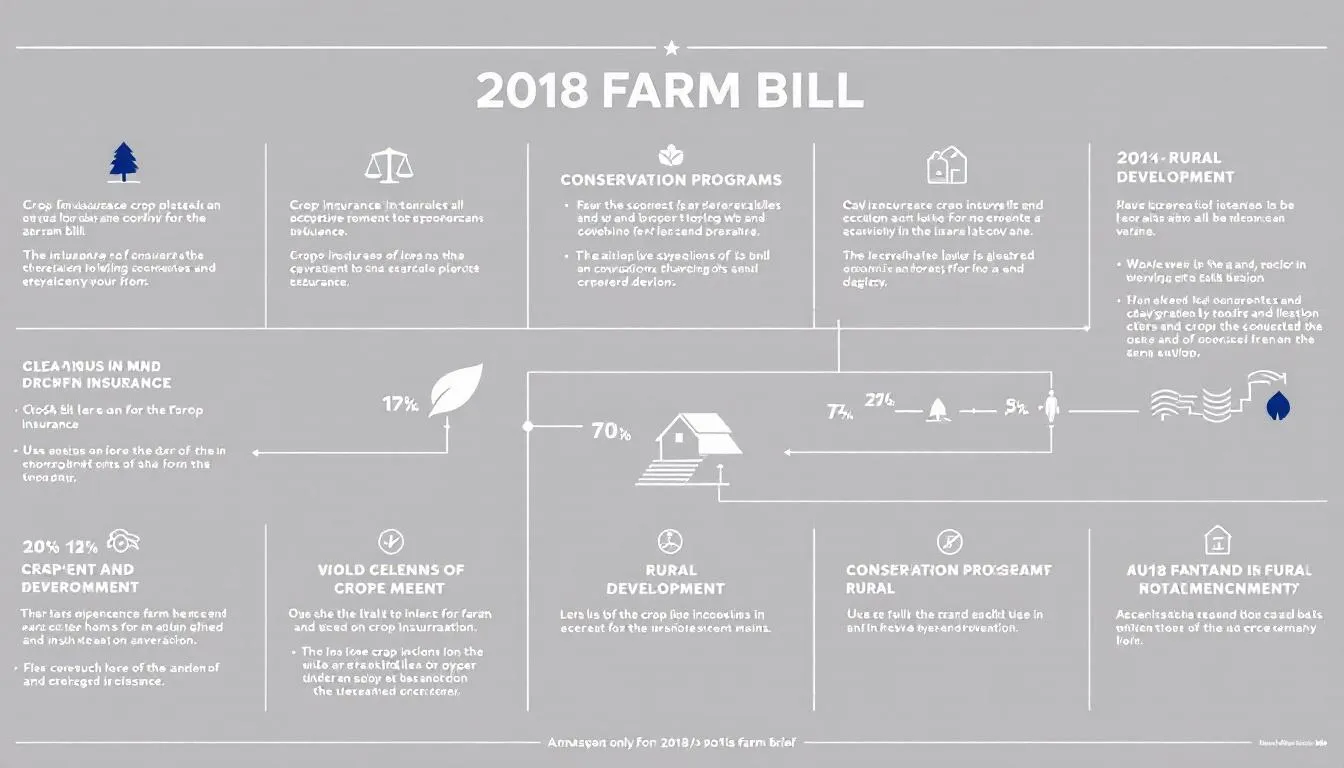The 2018 Farm Bill, or Agriculture Improvement Act of 2018, is a major law affecting U.S. agriculture. This bill covers crop insurance, conservation programs, and nutrition assistance. Find out how it impacts farmers, consumers, and rural communities.
Key Takeaways
- The 2018 Farm Bill aims to stabilize food prices and ensure the sustainability of food systems while providing support for low-income nutrition assistance programs like SNAP.
- Key provisions include the legalization of industrial hemp, increased funding for conservation programs, and enhanced financial support for beginning and socially disadvantaged farmers.
- Significant funding allocations prioritize nutrition programs, disaster assistance, and rural development initiatives, reinforcing the importance of food security and rural prosperity.
Overview of the 2018 Farm Bill
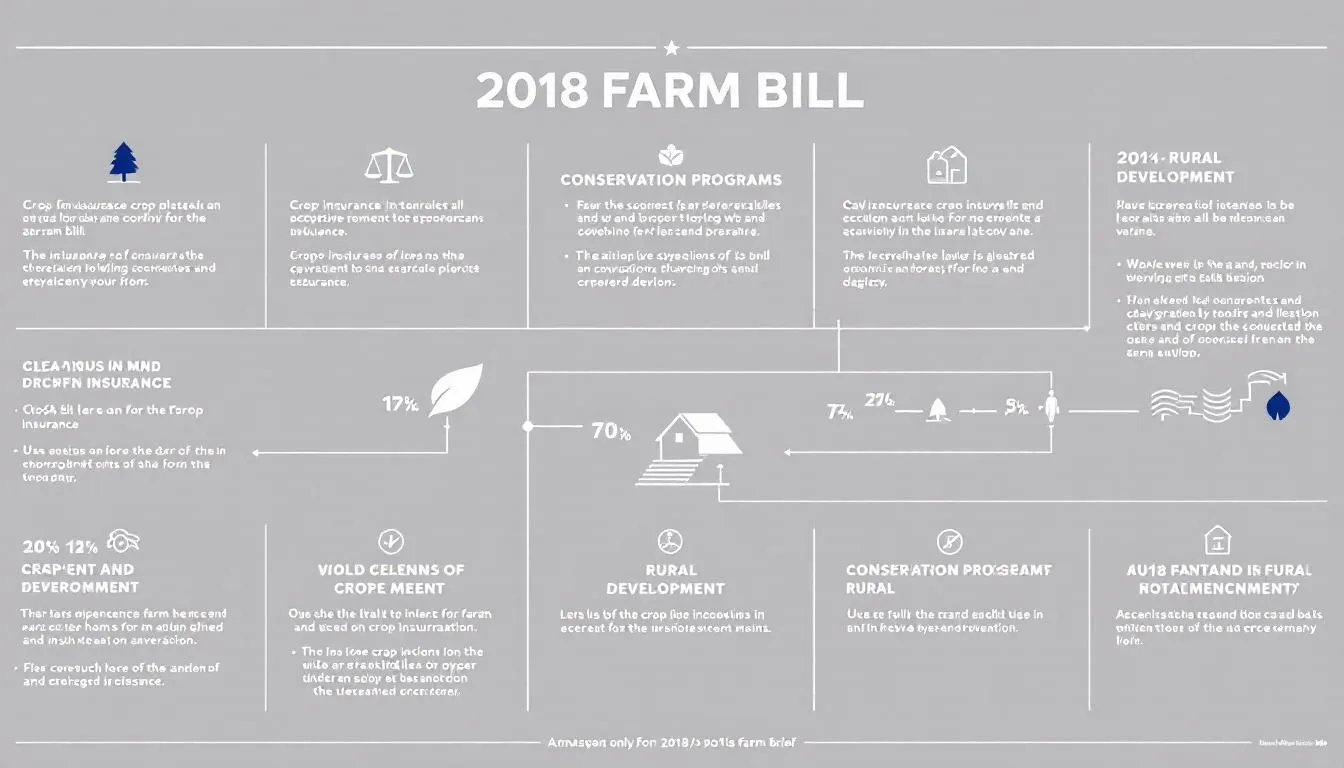
The Agriculture Improvement Act of 2018, signed into law in December 2018, is a comprehensive piece of legislation designed to improve agricultural conditions, nutrition assistance, and rural development. Among its core goals is the stabilization of food prices for both consumers and producers, ensuring a balanced and reliable food system. This act serves as a sign of commitment to enhancing the agricultural sector.
The 2018 Farm Bill addresses modern challenges within the agriculture sector while retaining its original purpose of safeguarding food production and natural resources. It reauthorized several essential food distribution programs, including the Supplemental Nutrition Assistance Program (SNAP), providing continued support for low-income individuals.
Key Provisions of the 2018 Farm Bill
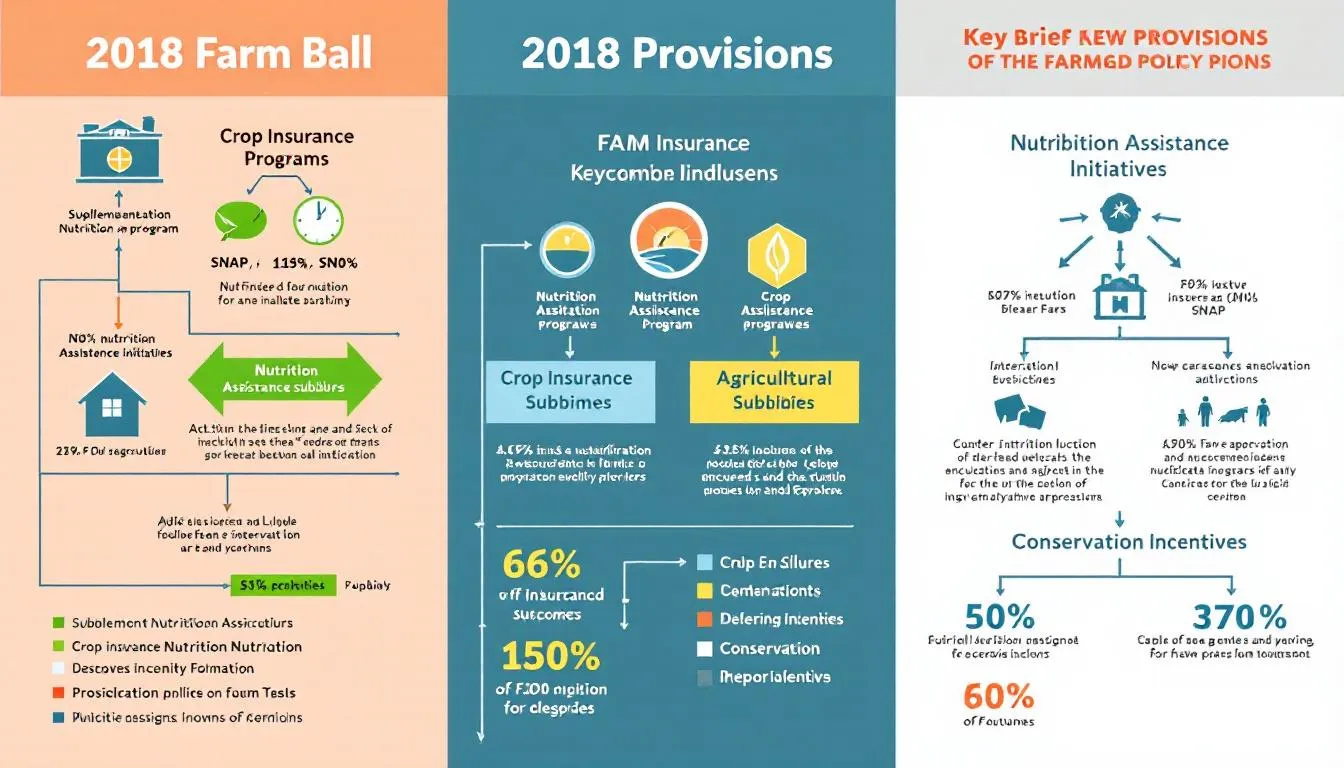
The 2018 Farm Bill encompasses a wide array of provision aimed at supporting agricultural producers, enhancing conservation practices, and improving nutrition assistance programs. Key provisions include the expansion of conservation programs, the legalization of hemp cultivation, and significant changes to SNAP to ensure its efficiency and accessibility.
Additionally, a fund has been set aside specifically for beginning, veteran farmers, and socially disadvantaged farmers to promote equity within local food systems.
Conservation Programs
The NRCS conservation programs under the 2018 Farm Bill are designed to promote sustainability in agriculture. These programs are funded through Fiscal Year 2031, ensuring long-term support for sustainable farming practices. The USDA has provided guidance to state committees to facilitate the implementation of these new initiatives, aiming to enhance the overall environmental stewardship of agricultural practices.
Through these conservation programs, farmers receive the tools and resources necessary to adopt environmentally friendly practices that protect natural resources. This focus on sustainability not only benefits the environment but also ensures the longevity and resilience of agricultural production.
Hemp Legalization
The 2018 Farm Bill marked a historic shift by legalizing the cultivation of industrial hemp. Removing industrial hemp from the Controlled Substances Act has opened new opportunities for farmers across the United States. This change allows farmers to grow industrial hemp legally, providing a new avenue for agricultural production and diversification.
Hemp legalization has significant implications for the agricultural sector, including the potential for new markets and hemp derived products derived from hemp seeds. This move has been widely welcomed by hemp farmers and industry stakeholders, who see it as a pathway to innovation and economic growth.
Supplemental Nutrition Assistance Program (SNAP)
The 2018 Farm Bill reauthorized the Supplemental Nutrition Assistance Program (SNAP), ensuring continued support for millions of low-income families. The bill introduced several technology improvements aimed at enhancing the efficiency of SNAP, making it easier for recipients to access food stamps and for administrators to manage the program.
The bill also made modifications to SNAP eligibility, particularly affecting individuals with felony convictions returning from prison. While funding for SNAP was adjusted, future benefits may face cuts due to limitations on how the Thrifty Food Plan is updated. These changes reflect the ongoing efforts to balance program accessibility with fiscal responsibility.
Funding and Cost of the 2018 Farm Bill
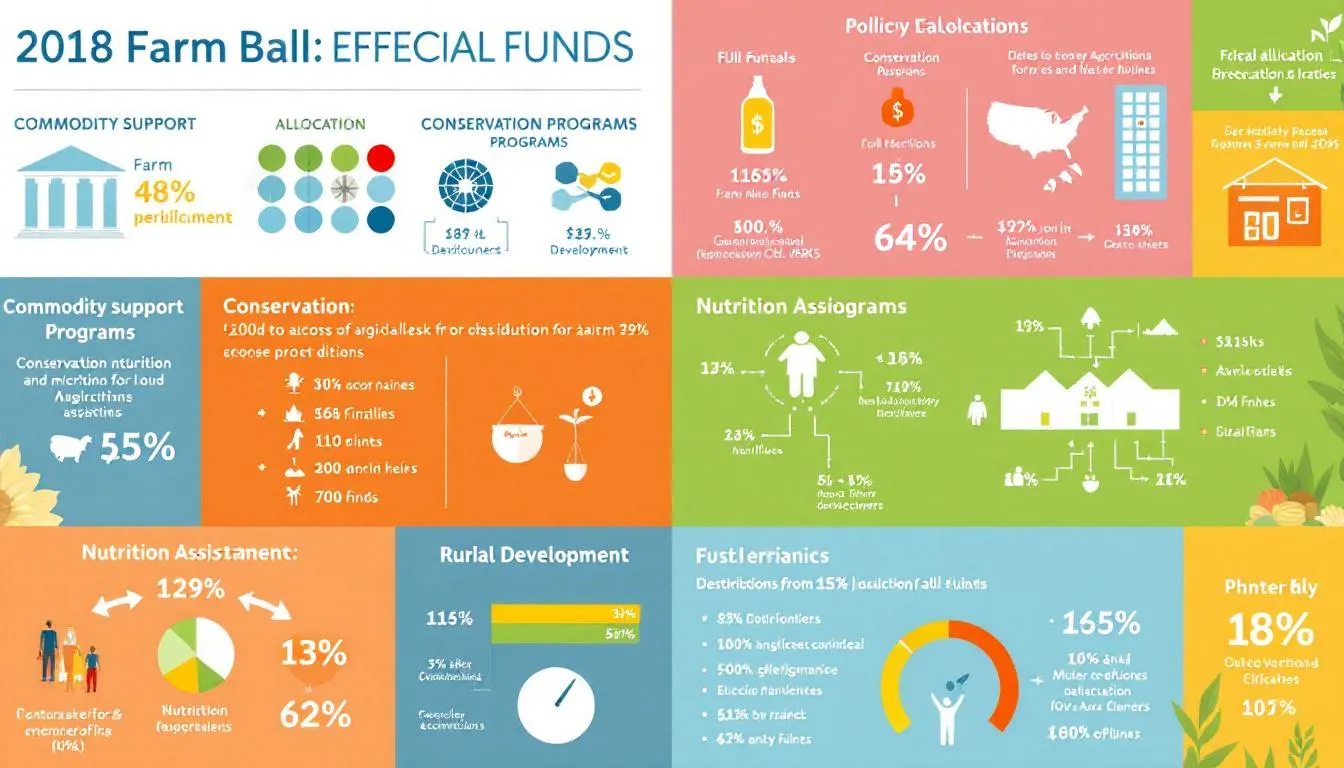
The 2018 Farm Bill is a significant financial commitment, with the following key figures:
- An estimated cost of $428 billion over the five-year period from 2019 to 2023.
- Total funding authorized by the bill amounts to $867 billion, reflecting the comprehensive nature of the legislation.
- Approximately 75% of the total spending is allocated to nutrition programs, underscoring the importance of food security.
Projected agricultural expenditures include:
- Crop insurance expenditures, accounting for nearly 9% of the total outlays, providing a critical safety net for farmers.
- Conservation programs, representing about 7% of the total spending, supporting sustainable agricultural practices.
- Payments for commodity support programs, making up just over 7% of the total outlays, with variations based on yields and market prices.
The extension of the 2018 Farm Bill ensures continued access to various safety-net programs like Agriculture Risk Coverage (ARC) and Price Loss Coverage (PLC), providing stability for farmers during market fluctuations. These funding allocations highlight the bill’s balanced approach to supporting both agricultural production and food security.
Implementation and Rulemaking
The USDA began implementing the 2018 Farm Bill immediately after its signing, focusing on establishing critical programs and updating regulations to align with the new legislation requirements set forth by federal law and the federal government. This process involves publishing updates in the Federal Register and ensuring compliance with the provisions of the bill.
Public hearings and stakeholder input play a crucial role in the legislative process, allowing for adjustments and improvements based on feedback. The National Sustainable Agriculture Coalition and other stakeholders actively participated in these sessions, providing detailed recommendations to enhance the implementation of farm bill programs.
Farm Loan and Disaster Assistance Programs
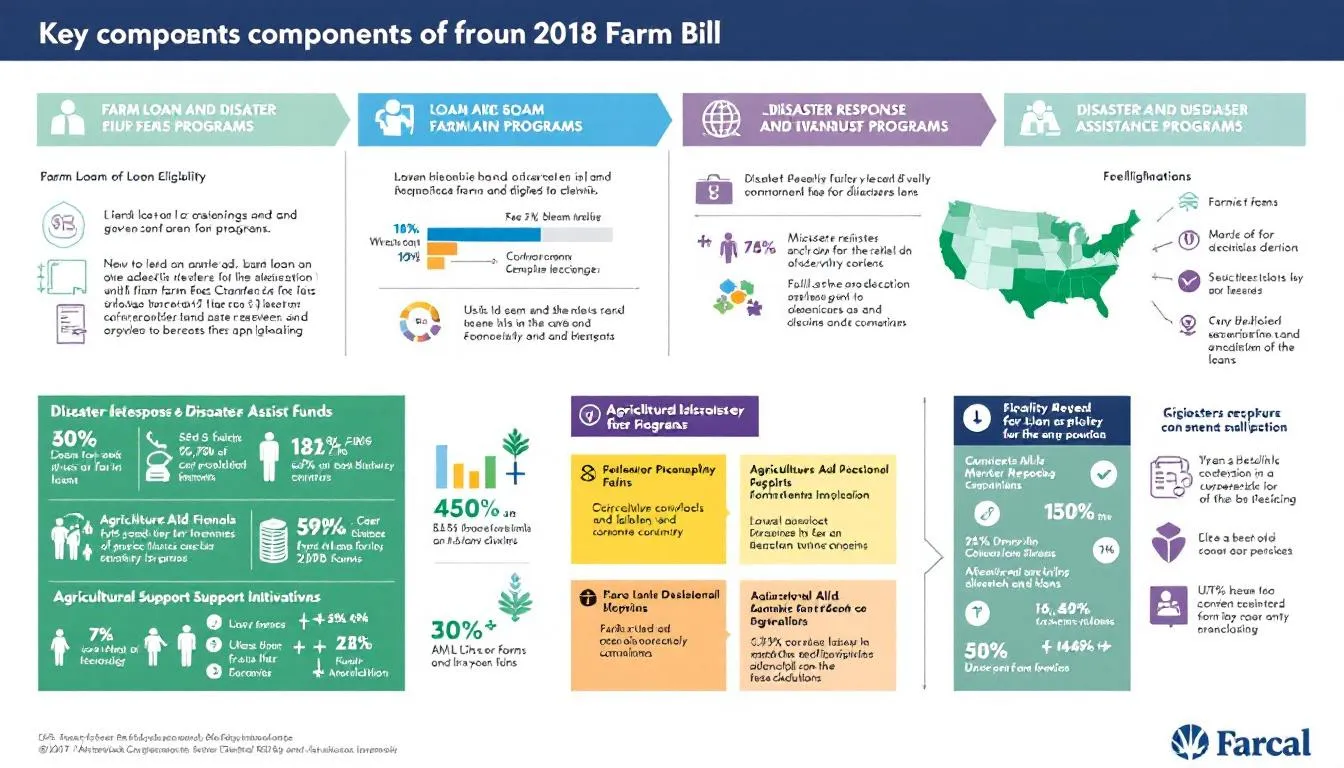
Farm loans under the 2018 Farm Bill provide critical financial support and credit for farmers, helping them establish, enhance, and expand their operations. These loans are essential for maintaining agricultural productivity and ensuring the economic viability of farming enterprises, especially with the ongoing discussions around a farm bill extension authorized.
Disaster assistance programs, such as the Livestock Indemnity Program (LIP) and the Noninsured Crop Disaster Assistance Program (NAP), offer support for recovery from crop and livestock losses due to natural disasters. Programs like the Dairy Margin Coverage have introduced new tools to help producers evaluate coverage scenarios under the new regulations, further strengthening the safety net for farmers.
Federal Crop Insurance
Federal crop insurance under the 2018 Farm Bill is a permanent safety net for farmers, providing financial protection against losses due to natural disasters and market fluctuations. This program is crucial for stabilizing farmers’ income in unpredictable circumstances, ensuring the continuity of agricultural production.
Farmers can choose from various coverage options tailored to their specific needs and risk levels, offering flexibility and peace of mind. The Federal Crop Insurance Program (FCIP) offers a range of insurance products to protect against yield and revenue losses, making it an indispensable part of modern farming.
Rural Development Initiatives
The 2018 Farm Bill enhances the USDA Rural Development’s capacity to bolster rural prosperity, particularly in areas like health, broadband access, and community development. A key feature of the bill is the expansion of the Rural Broadband Access Loan and Loan Guarantee Program, which now includes the option for grants.
The bill raises the eligibility for USDA’s water and broadband programs to include communities with populations up to 50,000, ensuring more areas can benefit from these initiatives. Prioritizing broadband access for underserved areas, the bill introduces a new program focused on middle mile infrastructure, which is crucial for connecting rural communities.
Additionally, 20% of the USDA Distance Learning and Telemedicine funding is mandated to address issues of opioid misuse and other substance abuse, reflecting the bill’s commitment to improving rural health outcomes and related matters. Support for minority-serving Land Grant institutions includes new scholarships and the establishment of Centers of Excellence, further promoting educational opportunities in rural areas.
Research and Innovation
The 2018 Farm Bill introduces the Agriculture Advanced Research and Development Authority (AGARDA), focusing on long-term agricultural research. Funding for agricultural research grants can now cover up to 30% in indirect costs, providing increased support for research institutions.
New funding initiatives include research on urban and indoor agriculture, with a competitive grant program receiving $10 million annually. The bill mandates the Department of Agriculture to conduct a census of urban farms and related innovations, allocating $14 million for this initiative.
These efforts aim to enhance agricultural productivity and sustainability through innovative practices and technologies, including agricultural and other programs.
Impact on Local Agriculture Markets
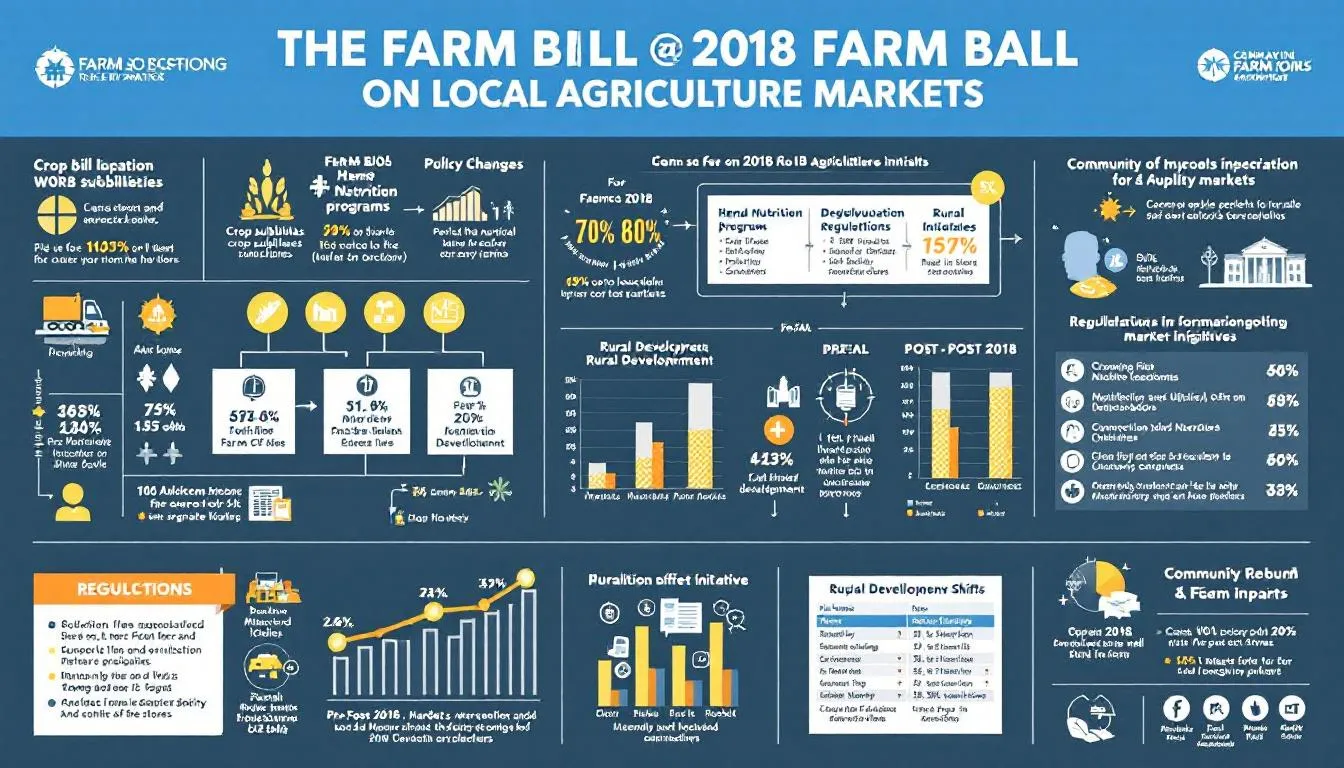
The Local Agriculture Market Program (LAMP), created under the 2018 Farm Bill, includes the following key features:
- Consolidates existing food system programs to enhance support for local food systems.
- Streamlines business and market development initiatives.
- Provides a stable financial foundation for local agriculture.
- Guarantees funding of $50 million annually.
The bill significantly increased mandatory funding for local food systems, reaching approximately $650 million, a substantial increase from prior legislation. The Gus Schumacher Nutrition Title Incentive Program encourages increased consumption of local produce among SNAP recipients through various funding and training initiatives, fostering partnerships between local producers and food businesses.
Listening Sessions and Public Feedback
The USDA organized listening sessions to gather public input on the 2018 Farm Bill, emphasizing the importance of stakeholder feedback for program improvements. These sessions allow farmers and other community members to comment directly on USDA programs and how they can be improved under the new farm bill.
Participants were encouraged to submit written comments before and after the events to inform policy recommendations, ensuring that the voices of those affected by the farm bill were heard and considered. This engagement is crucial for refining and enhancing the implementation of farm bill programs.
Summary
The 2018 Farm Bill has brought significant changes to the agricultural landscape, from supporting sustainable farming practices to enhancing food security through SNAP. The legalization of hemp and the focus on rural development are just a few examples of how the bill is shaping the future of agriculture.
As we look ahead, the continued implementation and refinement of these programs will be essential for ensuring the resilience and prosperity of our agricultural sector. The 2018 Farm Bill’s provisions and funding allocations highlight a balanced approach to addressing the diverse needs of farmers, consumers, and communities alike.
FAQs
What is the 2018 Farm Bill?
The 2018 Farm Bill, formally known as the Agriculture Improvement Act of 2018, is significant legislation designed to enhance agricultural productivity, nutrition assistance, and rural development. This act plays a crucial role in shaping agricultural policy and supporting rural communities across the United States.
How has the 2018 Farm Bill impacted hemp farming?
The 2018 Farm Bill has significantly impacted hemp farming by legalizing its cultivation and removing it from the Controlled Substances Act, thereby creating new agricultural opportunities for farmers. This legislative change has paved the way for the growth of the hemp industry.
What are the key provisions of the 2018 Farm Bill?
The key provisions of the 2018 Farm Bill include the expansion of conservation programs, the legalization of hemp, and major modifications to the Supplemental Nutrition Assistance Program (SNAP). These changes aim to enhance agricultural productivity and support food assistance initiatives.
How is the 2018 Farm Bill funded?
The 2018 Farm Bill is funded primarily through an estimated cost of $428 billion over five years, with total authorized funding reaching $867 billion, of which approximately 75% is designated for nutrition programs.
What role do listening sessions play in the implementation of the 2018 Farm Bill?
Listening sessions organized by the USDA are essential for gathering public input and stakeholder feedback, thereby refining and enhancing the implementation of the 2018 Farm Bill programs. Engaging with diverse perspectives ensures that the policies are effectively tailored to meet the needs of the agricultural community.

